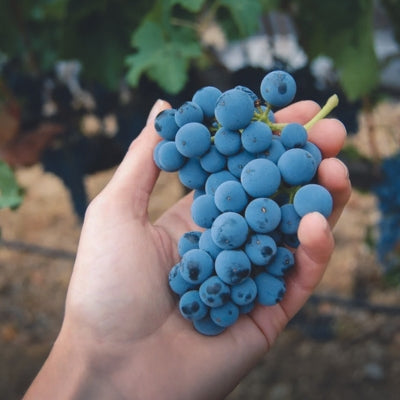
Grape school: Merlot
Placing aside second-hand opinions from Paul Giamatti’s character Miles in Sideways, Merlot is one of the world’s most important and widely grown grape varieties, known for its soft, approachable character and versatility. Originating from the Bordeaux region of France, it has since become a staple in vineyards from California to Chile, Italy to Australia.
Origins and history
Merlot is believed to have originated in the Bordeaux region, or at least that is where the earliest recorded mention suggests. Further evidence refers to it as lou seme doù flube – ‘the seedling from the river’ – giving rise to the idea that it came from one of the islands found along the Garonne River. Historical records indicate that Merlot has been cultivated since at least the late 18th century.
The name "Merlot" is thought to be derived from the diminutive form of the French word merle, meaning “little blackbird”. This is likely due to its blue-black coloring being similar to the bird’s plumage and its apparent fondness for the fruit.
Along with grapes including Cabernet Sauvignon, Carménère, and Malbec, Merlot is an offspring of Cabernet Franc, a lineage that contributes to its sometimes green and vegetal aromatic compounds called methoxypyrazines.
Merlot gained prominence in Bordeaux's Right Bank regions, such as Saint-Émilion and Pomerol, where it produces some of the world's most prestigious wines. The grape's adaptability and relatively early ripening made it an attractive choice for winemakers, allowing it to spread to other wine regions across the globe throughout the 19th and 20th centuries.
Appearance and growing conditions
Merlot grapes are medium to large in size, with dark blue-black skin. The vines thrive in a variety of soil types but prefer clay-rich soils that retain moisture. Merlot is known for its ability to ripen earlier than many other red grape varieties, which helps to avoid adverse weather conditions late in the growing season.
Merlot is also relatively hardy and can adapt to both cooler and warmer climates, although it tends to perform best in moderate conditions. In cooler climates, it maintains good acidity and develops a more structured profile, while in warmer regions, it produces fruit-forward wines with softer tannins. Merlot has a tendency to overripen shortly after its initial ripeness has occurred, leading to different approaches in the timing of harvest.
Flavor profile
The flavor profile of Merlot is characterized by its lush, fruity nature, however, it can vary depending on factors such as terroir or regional styles. For instance, the traditional Bordeaux style sees earlier harvesting which preserves acidity and leafier, more vegetal notes, tending towards good aging potential. By contrast, the International style favors later harvesting to promote phenolic ripeness for richer, more full-bodied wines with soft, velvet tannins.
Common flavor notes include black cherry, plum, and raspberry, often complemented by hints of chocolate, bay leaf, and cedar. The grape’s natural softness and lower tannin levels contribute to its smooth, velvety texture, making it an easy-drinking wine that appeals to a broad audience.
Merlot can also exhibit complex secondary flavors when aged, such as tobacco, leather, and earthy undertones. The use of oak aging can add layers of vanilla, clove, and spice, further enhancing its appeal. Its versatility allows it to be crafted into a range of styles, from light and fruity to rich and robust.
Food pairings
Merlot's approachable nature and balanced structure make it a versatile wine for food pairings. It pairs beautifully with a wide variety of dishes, from roasted poultry and grilled meats to pasta with red sauce and hearty stews. The wine's fruit-forward character complements dishes with savory and umami flavors, such as mushrooms, duck, and lamb.
Lighter, unoaked Merlots are excellent with charcuterie, mild cheeses, and light salads, while richer, oak-aged versions can stand up to stronger flavors like barbecue, aged cheeses, and spicy cuisines. The wine's inherent softness and moderate acidity make it a flexible choice for many culinary traditions.
Notable producers
France remains the benchmark for high-quality Merlot, particularly in the Bordeaux region. Château Pétrus in Pomerol is perhaps the most famous Merlot producer, known for its legendary-tier wines. Other notable Bordeaux producers include Château Cheval Blanc and Château Angélus from Saint-Émilion where Merlot forms a significant part of the blend.
Outside of France, Merlot has thrived in regions such as California's Napa Valley, where producers like Duckhorn and Kapcsandy have garnered acclaim. In Italy, Merlot is a key component of the "Super Tuscans", with producers like Tenuta dell'Ornellaia’s 100% Merlot Masseto and Tua Rita’s single-varietal Redigaffi setting an impressive benchmark for Merlot grown on Italian soils.
Conclusion
From the elegant, structured wines of Bordeaux to the plush, fruit-forward expressions from California and beyond, Merlot offers a diverse range of styles to suit many palates. Its adaptability to different climates and winemaking techniques ensures that Merlot remains a cornerstone of the wine world.
Want to read more? Take a look at some of our other blogs:



